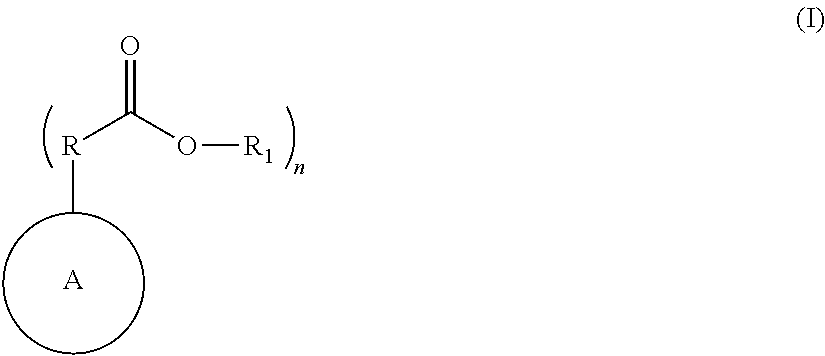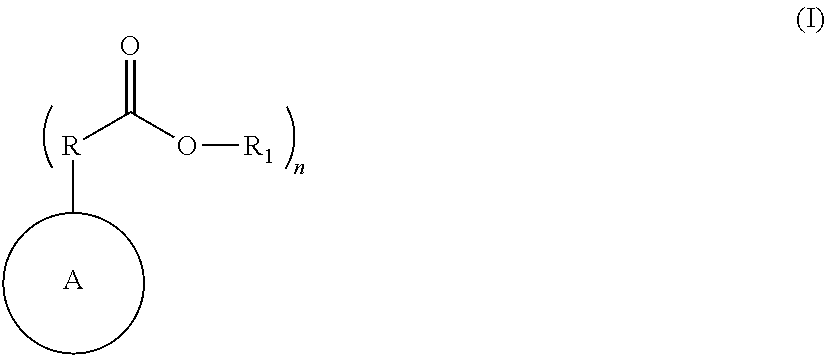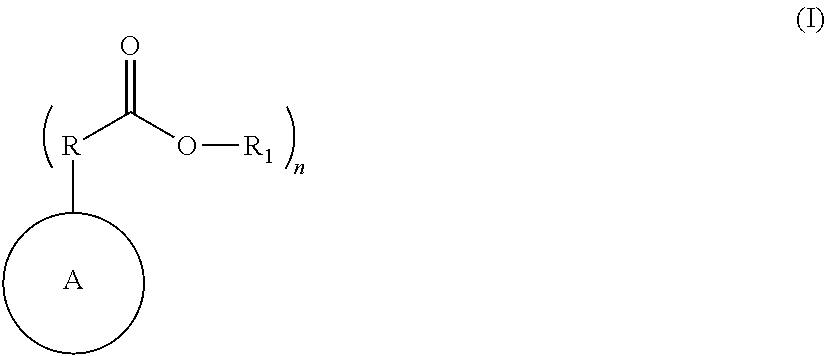Nitrogen containing polymers as levelers
a technology of nitrogen containing polymers and levelers, which is applied in the direction of printed circuit manufacturing, conductive pattern formation, coatings, etc., can solve the problems of uneven metal deposits, difficult steps in forming substantially uniform layers, and difficulty in plating a substrate with irregular topography, etc., to achieve the effect of increasing the throwing power, and reducing the difficulty of plating unevenly
- Summary
- Abstract
- Description
- Claims
- Application Information
AI Technical Summary
Benefits of technology
Problems solved by technology
Method used
Image
Examples
example 1
[0055]6.8 g (100 mmols) of imidazole and 2.4 g (100 mmols) of sodium hydride were dissolved in 50 ml of anhydrous THF. The mixture was stirred and cooled in an ice bath for 2 hours until the formation of hydrogen gas ceased. 21.6 g (200 mmols) of ethyl chloroacetate was added and the mixture was refluxed for 12 hours. After removing the solvent by evaporation, the remaining residue was extracted by acetonitrile to obtain 1H-imidazolium 1,3-bis(2-methoxy-2-oxoethyl). The end product was confirmed by NMR spectrum. The NMR spectra were recorded at 25° C. using a Bruker 400 MHz spectrometer operating at 400.13 MHz for 1H NMR.
[0056]To a three necked flask 4 g (15.3 mmols) of 1H-imidazolium 1,3-bis(2-methoxy-2-oxoethyl), 1.7 g (15.3 mmols) of hexamethylenediamine and 20 ml of acetonitrile were added. The mixture was refluxed for 48 hours in an inert N2 atmosphere. The final product (product 1) precipitated out during the reaction. The final product was confirmed by NMR spectrum which had ...
example 2
[0059]8.2 g (100 mmols) of 4-methyl imidazole and 2.4 g (100 mmols) of sodium hydride were dissolved in 50 ml of anhydrous THF. The mixture was stirred and cooled in an ice bath for 2 hours until the formation of hydrogen gas ceased. 21.6 g (200 mmols) of ethyl chloroacetate was then added to the mixture. After refluxing for 12 hours the solvent was removed by evaporation and the remaining residue was extracted by acetonitirile to obtain 1H-imidazolium 1,3-bis(2-methoxy-2-oxoethyl). The end product was confirmed by NMR spectrum.
[0060]To a three necked flask 4.2 g (15.3 mmols) of 1H-4-methyl imidazolium 1,3-bis(2-methoxy-2-oxoethyl), 1.7 g (15.3 mmols) of hexamethylenediamine and 20 ml of acetonitrile were added. The mixture was refluxed for 48 hours under an inert N2 atmosphere. The final product (product 2) precipitated out during the reaction. The product was confirmed as having the same general formula as XIII by NMR spectrum. The molecular weight of the final product was determi...
PUM
| Property | Measurement | Unit |
|---|---|---|
| temperatures | aaaaa | aaaaa |
| diameter | aaaaa | aaaaa |
| depth | aaaaa | aaaaa |
Abstract
Description
Claims
Application Information
 Login to View More
Login to View More - R&D
- Intellectual Property
- Life Sciences
- Materials
- Tech Scout
- Unparalleled Data Quality
- Higher Quality Content
- 60% Fewer Hallucinations
Browse by: Latest US Patents, China's latest patents, Technical Efficacy Thesaurus, Application Domain, Technology Topic, Popular Technical Reports.
© 2025 PatSnap. All rights reserved.Legal|Privacy policy|Modern Slavery Act Transparency Statement|Sitemap|About US| Contact US: help@patsnap.com



